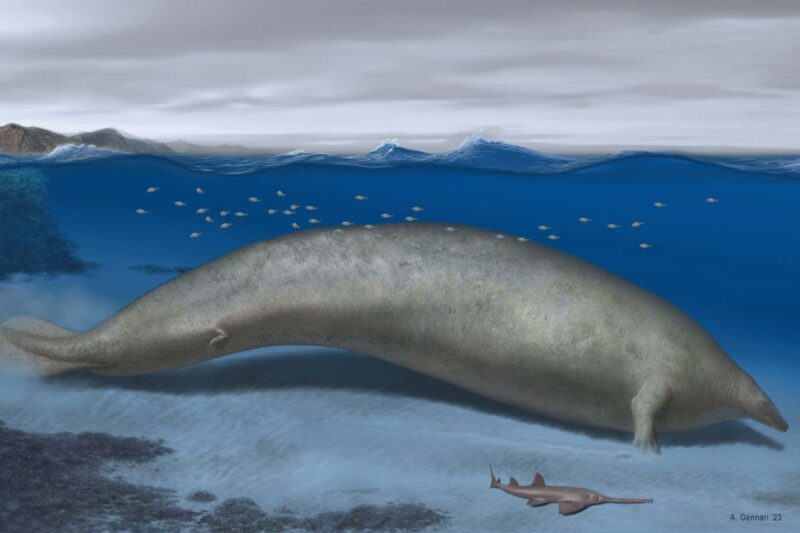Reconstruction of Perucetus colossus, a whale that lived in coastal waters around 39 million years ago
Alberto Gennari
A colossal type of ancient whale, discovered in Peru, has been identified as one of the largest creatures to have ever existed.
In 2010, scientists conducting research in southern Peru stumbled upon an unusual object emerging from the ground. Eli Amson, from the State Museum of Natural History Stuttgart in Germany, explains that the object was so strange that they were unsure if it was actually bone.
Only during the excavation did they realize that the object was indeed a bone from an enormous cetacean, a family of aquatic mammals that includes whales and dolphins.
Since then, Amson and his colleagues have found additional bones of this animal, assembling a partial skeleton comprising four ribs, 13 vertebrae, and a small, damaged pelvic bone. Through carbon dating of the surrounding sediment, the team has estimated that the specimen is approximately 39 million years old.
By comparing the bones with those of similar species from the same era, the team reconstructed a model of what the complete skeleton might have looked like. They determined that the creature belonged to a new whale species, which they named Perucetus colossus. In comparison to the closely related ancient whale Cynthiacetus peruvianus, they found that it had a relatively small head in proportion to its massive body.
From the model, the researchers estimate that P. colossus measured around 20 meters in length and weighed between 85 and 340 tonnes. The largest recorded weight of a blue whale is 190 tonnes, making P. colossus a strong candidate for one of the heaviest animals to have ever roamed the Earth.
The immense size of P. colossus suggests that whales may have experienced a significant increase in size 30 million years earlier in their evolutionary history than previously thought, says Amson.
While massive cetaceans, like the blue whale, are commonly associated with the deep ocean, P. colossus, believed to have inhabited coastal waters, demonstrates an alternative pathway to achieving gigantism. According to Amson, this discovery has reshaped our understanding of cetacean evolution and the acquisition of extreme gigantism.
Lars Schmitz from Claremont McKenna College in California remarks, “What a remarkable find! Estimating body mass in fossils is always challenging, but there is no doubt that this whale was incredibly large.”
Unfortunately, the absence of a skull prevents us from determining how this massive creature would have fed, says Neil Kelley from Vanderbilt University in Tennessee. “Hopefully, future fossil discoveries will shed light on these questions and provide a clearer picture of this enigmatic extinct whale.”
Topics:








